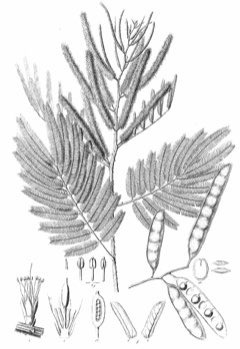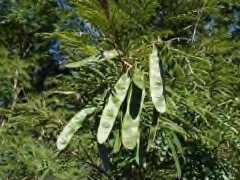 |
|
http://www.edibleplants.org |
 |
| João Medeiros wikimedia.org |
Translate this page:
Summary
Piptadenia gonoacantha is a fast-growing, semi deciduous tree characterized by an open and ellipsoidal crown. It can be found in South America. Belonging in the legume family, it is capable of fixing atmospheric nitrogen due to its symbiotic relationship with certain soil bacteria that form root nodules. The wood is moderately heavy, hard, and moderately resistant to termites. It is used as material for a furniture, indoor finishing, toys, door panels, etc, and as fuel and for charcoal making.
Physical Characteristics

 Piptadenia gonoacantha is a deciduous Tree growing to 15 m (49ft) by 15 m (49ft) at a fast rate.
Piptadenia gonoacantha is a deciduous Tree growing to 15 m (49ft) by 15 m (49ft) at a fast rate.
See above for USDA hardiness. It is hardy to UK zone 10. The flowers are pollinated by Bees.
It can fix Nitrogen.
Suitable for: light (sandy), medium (loamy) and heavy (clay) soils, prefers well-drained soil and can grow in nutritionally poor soil. Suitable pH: mildly acid, neutral and basic (mildly alkaline) soils. It cannot grow in the shade. It prefers dry or moist soil and can tolerate drought.
UK Hardiness Map
US Hardiness Map
Synonyms
Acacia gonoacantha Mart. Piptadenia communis Benth. Pityrocarpa gonoacantha (Mart.) Brenan
Plant Habitats
Edible Uses
References More on Edible Uses
Medicinal Uses
Plants For A Future can not take any responsibility for any adverse effects from the use of plants. Always seek advice from a professional before using a plant medicinally.
None known
References More on Medicinal Uses
The Bookshop: Edible Plant Books
Our Latest books on Perennial Plants For Food Forests and Permaculture Gardens in paperback or digital formats.

Edible Tropical Plants
Food Forest Plants for Hotter Conditions: 250+ Plants For Tropical Food Forests & Permaculture Gardens.
More

Edible Temperate Plants
Plants for Your Food Forest: 500 Plants for Temperate Food Forests & Permaculture Gardens.
More

More Books
PFAF have eight books available in paperback and digital formats. Browse the shop for more information.
Shop Now
Other Uses
Charcoal Containers Fuel Furniture Pioneer Wood
Agroforestry Uses: A fast-growing, pioneer species that has a fairly open crown and also fixes atmospheric nitrogen, it is a good choice as a pioneer species for restoring native woodlands and also for establishing woodland gardens[419 ]. Other Uses The wood is thick-textured; irregular-grained; moderately heavy; hard to cut, but soft to work with; medium resistance to the attacks of wood-eating organisms. It is used for indoor finishing, furniture frames, door panels, toys and packing cases[419 ]. One of the best woods in Brazil for use as fuel and for making charcoal[419 ].
Special Uses
Food Forest Nitrogen Fixer
References More on Other Uses
Cultivation details
Requires a sunny position[419 ]. Succeeds in a range of soils, including poor ones[419 ]. A fast-growing plant, easily reaching a height of 5 metres within 2 years from seed[419 ]. This species has a symbiotic relationship with certain soil bacteria, these bacteria form nodules on the roots and fix atmospheric nitrogen. Some of this nitrogen is utilized by the growing plant but some can also be used by other plants growing nearby[755 ].
References Carbon Farming Information and Carbon Sequestration Information
Temperature Converter
Type a value in the Celsius field to convert the value to Fahrenheit:
Fahrenheit:
The PFAF Bookshop
Plants For A Future have a number of books available in paperback and digital form. Book titles include Edible Plants, Edible Perennials, Edible Trees,Edible Shrubs, Woodland Gardening, and Temperate Food Forest Plants. Our new book is Food Forest Plants For Hotter Conditions (Tropical and Sub-Tropical).
Shop Now
Plant Propagation
Seed - best sown as soon as it is ripe in a partially shaded position in a nursery seedbed or in individual containers. A very high germination rate can be expected from fresh seed, with the seed sprouting within 5 - 10 days[419 ]. When the seedbed-sown seedlings are 4 - 6cm tall, pot them up into individual containers and they should be ready to plant out 3 - 4 months later[419 ]. The seeds have a very short viability in storage[419 ].
Other Names
If available other names are mentioned here
Native Plant Search
Search over 900 plants ideal for food forests and permaculture gardens. Filter to search native plants to your area. The plants selected are the plants in our book 'Plants For Your Food Forest: 500 Plants for Temperate Food Forests and Permaculture Gardens, as well as plants chosen for our forthcoming related books for Tropical/Hot Wet Climates and Mediterranean/Hot Dry Climates. Native Plant Search
Found In
Countries where the plant has been found are listed here if the information is available
Brazil; Bolivia, Plurinational State of; Paraguay
Weed Potential
Right plant wrong place. We are currently updating this section.
Please note that a plant may be invasive in one area but may not in your area so it’s worth checking.
Conservation Status
IUCN Red List of Threatened Plants Status : This taxon has not yet been assessed

Growth: S = slow M = medium F = fast. Soil: L = light (sandy) M = medium H = heavy (clay). pH: A = acid N = neutral B = basic (alkaline). Shade: F = full shade S = semi-shade N = no shade. Moisture: D = dry M = Moist We = wet Wa = water.

Expert comment
Author
(Mart.) J.F.Macbr.
Botanical References
Links / References
For a list of references used on this page please go here
A special thanks to Ken Fern for some of the information used on this page.
Readers comment
| Add a comment |
|
If you have important information about this plant that may help other users please add a comment or link below. Only comments or links that are felt to be directly relevant to a plant will be included. If you think a comment/link or information contained on this page is inaccurate or misleading we would welcome your feedback at [email protected]. If you have questions about a plant please use the Forum on this website as we do not have the resources to answer questions ourselves.
* Please note: the comments by website users are not necessarily those held by PFAF and may give misleading or inaccurate information.
To leave a comment please Register or login here All comments need to be approved so will not appear immediately.
|
Subject : Piptadenia gonoacantha
|
|
|
|